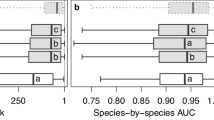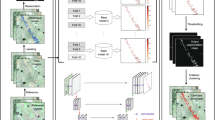Abstract
Species distribution models (SDM) assess and predict how species spatial distributions depend on the environment, due to species ecological preferences. These models are used in many different scenarios such as conservation plans or monitoring of invasive species. The choice of a model and of environmental data have strong impact on the model’s ability to capture important ecological information. Specifically, state-of-the-art models generally rely on local, punctual environmental information, and do not take into account environmental variation in surrounding landscape. Here we use a convolutional neural network model to analyze and predict species distributions depending on high resolution data including remote sensing images, land cover and altitude. We show that the model unravel the functional response of vegetation to both local and large-scale environmental variation. To demonstrate the ecological significance of the results, we propose an original statistical analysis of t-SNE nonlinear dimension reduction. We illustrate and test the traits-species-environment relationships learned by the model and expressed in t-SNE dimensions.
Access this chapter
Tax calculation will be finalised at checkout
Purchases are for personal use only
Similar content being viewed by others
Notes
- 1.
- 2.
- 3.
- 4.
- 5.
Test occurrences are contained in \(5 \times 5\) km quadrats with no train occurrences and represent 2.5% of the overall set.
References
Antoine, G., Wilfried, T.: Predicting species distribution: offering more than simple habitat models. Ecol. Lett. 8(9), 993–1009 (2005). https://doi.org/10.1111/j.1461-0248.2005.00792.x
Baran, P., Lek, S., Delacoste, M., Belaud, A.: Stochastic models that predict trout population density or biomass on a mesohabitat scale. Hydrobiologia 337(1), 1–9 (1996). https://doi.org/10.1007/BF00028502
Bartelheimer, M., Poschlod, P.: Functional characterizations of Ellenberg indicator values-a review on ecophysiological determinants. Funct. Ecol. 30(4), 506–516 (2016)
Benkendorf, D.J., Hawkins, C.P.: Effects of sample size and network depth on a deep learning approach to species distribution modeling. Ecol. Inform. 60, 101137 (2020)
Botella, C., Joly, A., Bonnet, P., Monestiez, P., Munoz, F.: A deep learning approach to species distribution modelling. In: Joly, A., Vrochidis, S., Karatzas, K., Karppinen, A., Bonnet, P. (eds.) Multimedia Tools and Applications for Environmental & Biodiversity Informatics. MSA, pp. 169–199. Springer, Cham (2018). https://doi.org/10.1007/978-3-319-76445-0_10
Chen, D., Xue, Y., Chen, S., Fink, D., Gomes, C.P.: Deep multi-species embedding. CoRR abs/1609.09353 (2016). http://arxiv.org/abs/1609.09353
Christin, S., Hervet, É., Lecomte, N.: Applications for deep learning in ecology. Methods Ecol. Evol. 10(10), 1632–1644 (2019)
Cole, E., et al.: The GeoLifeCLEF 2020 dataset. ar**v preprint ar**v:2004.04192 (2020)
Cutler, D.R., et al.: Random forests for classification in ecology. Ecology 88(11), 2783–2792 (2007). https://doi.org/10.1890/07-0539.1
De’ath, G.: Boosted trees for ecological modeling and prediction. Ecology 88(1), 243–251 (2007). https://doi.org/10.1890/0012-9658(2007)88[243:BTFEMA]2.0.CO;2
Deneu, B., Servajean, M., Joly, A.: Participation of LIRMM/Inria to the geo-lifeclef 2020 challenge. CLEF working notes (2020)
Deneu, B., Joly, A., Bonnet, P., Servajean, M., Munoz, F.: Supplementary materials: How do deep convolutional SDM trained on satellite images unravel vegetation ecology? https://gitlab.inria.fr/bdeneu/supplementary-materials-maes2020-paper-19
Deneu, B., Servajean, M., Botella, C., Joly, A.: Location-based species recommendation using co-occurrences and environment- GeoLifeCLEF 2018 challenge. In: CLEF Working Notes 2018 (2018)
Elith, J., Leathwick, J.R.: Species distribution models: ecological explanation and prediction across space and time. Annu. Rev. Ecol. Evol. Syst. 40, 677–697 (2009)
Elith, J., Leathwick, J.R., Hastie, T.: A working guide to boosted regression trees. J. Anim. Ecol. 77(4), 802–813 (2008). https://doi.org/10.1111/j.1365-2656.2008.01390.x
Ellenberg, H.H.: Vegetation Ecology of Central Europe. Cambridge University Press, Cambridge (1988)
Guisan, A., Zimmermann, N.E.: Predictive habitat distribution models in ecology. Ecol. Model. 135(2), 147–186 (2000). https://doi.org/10.1016/S0304-3800(00)00354-9
Hengl, T., et al.: SoilGrids250m: global gridded soil information based on machine learning. PLoS One 12(2), e0169748 (2017)
Hijmans, R.J., Cameron, S.E., Parra, J.L., Jones, P.G., Jarvis, A.: Very high resolution interpolated climate surfaces for global land areas. Int. J. Climatol. J. R. Meteorol. Soc. 25(15), 1965–1978 (2005)
Homer, C., et al.: Completion of the 2011 national land cover database for the conterminous united states-representing a decade of land cover change information. Photogram. Eng. Remote Sens. 81(5), 345–354 (2015)
LeCun, Y., et al.: Backpropagation applied to handwritten zip code recognition. Neural Comput. 1(4), 541–551 (1989)
Lek, S., Delacoste, M., Baran, P., Dimopoulos, I., Lauga, J., Aulagnier, S.: Application of neural networks to modelling nonlinear relationships in ecology. Ecol. Model. 90(1), 39–52 (1996). https://doi.org/10.1016/0304-3800(95)00142-5
Maaten, L., Hinton, G.: Visualizing data using t-SNE. J. Mach. Learn. Res. 9, 2579–2605 (2008)
Miller, J.E., Damschen, E.I., Ives, A.R.: Functional traits and community composition: a comparison among community-weighted means, weighted correlations, and multilevel models. Methods Ecol. Evol. 10(3), 415–425 (2019)
Peterson, A.T.: Ecological Niches and Geographic Distributions. Princeton University Press, Princeton (2011)
Phillips, S.J., Anderson, R.P., Schapire, R.E.: Maximum entropy modeling of species geographic distributions. Ecol. Model. 190(3–4), 231–259 (2006)
Phillips, S.J., Dudík, M.: Modeling of species distributions with maxent: new extensions and a comprehensive evaluation. Ecography 31(2), 161–175 (2008). https://doi.org/10.1111/j.0906-7590.2008.5203.x
Szegedy, C., Vanhoucke, V., Ioffe, S., Shlens, J., Wojna, Z.: Rethinking the inception architecture for computer vision. In: Proceedings of the IEEE Conference on Computer Vision and Pattern Recognition, pp. 2818–2826 (2016)
Violle, C., Reich, P.B., Pacala, S.W., Enquist, B.J., Kattge, J.: The emergence and promise of functional biogeography. Proc. Natl. Acad. Sci. 111(38), 13690–13696 (2014)
Acknowledgement
This project has received funding from the French National Research Agency under the Investments for the Future Program, referred as ANR-16-CONV-0004 and from the European Union’s Horizon 2020 research and innovation program under grant agreement No 863463 (Cos4Cloud project).
Author information
Authors and Affiliations
Corresponding author
Editor information
Editors and Affiliations
Rights and permissions
Copyright information
© 2021 Springer Nature Switzerland AG
About this paper
Cite this paper
Deneu, B., Joly, A., Bonnet, P., Servajean, M., Munoz, F. (2021). How Do Deep Convolutional SDM Trained on Satellite Images Unravel Vegetation Ecology?. In: Del Bimbo, A., et al. Pattern Recognition. ICPR International Workshops and Challenges. ICPR 2021. Lecture Notes in Computer Science(), vol 12666. Springer, Cham. https://doi.org/10.1007/978-3-030-68780-9_15
Download citation
DOI: https://doi.org/10.1007/978-3-030-68780-9_15
Published:
Publisher Name: Springer, Cham
Print ISBN: 978-3-030-68779-3
Online ISBN: 978-3-030-68780-9
eBook Packages: Computer ScienceComputer Science (R0)





